Experimental Study on Performance of Transonic Compressor Cascade with Microgroove Polyurethane Coatings
Abstract
:1. Introduction
2. Test Section
2.1. Description of Compressor Cascade
2.2. Microgroove Polyurethane Coating Preparation
3. Experimental System
3.1. Test Apparatus
3.2. Test Procedure and Conditions
3.3. Data Reduction
3.4. Analysis of Experimental Error
4. Results
4.1. Total Pressure Loss
4.2. Flow Turning Angle
5. Discussion
6. Conclusions
Author Contributions
Funding
Institutional Review Board Statement
Informed Consent Statement
Data Availability Statement
Acknowledgments
Conflicts of Interest
References
- Kan, X.; Wu, W.; Zhong, J. Effects of vortex dynamics mechanism of blade-end treatment on the flow losses in a compressor cascade at critical condition. Aerosp. Sci. Technol. 2020, 102, 105857. [Google Scholar] [CrossRef]
- Chen, F.-Q.; Li, X.-S.; Hu, B.; Ren, X.-D.; Wang, Z.-Y.; Gu, C.-W. Pressure drop analysis and aerodynamic design of compressor L-inlet duct. Aerosp. Sci. Technol. 2020, 107, 106324. [Google Scholar] [CrossRef]
- Huang, G.; Yang, Y.; Hong, S.; Liu, Z.; Du, S. A new unsteady casing treatment for micro centrifugal compressors to enlarge stall margin. Aerosp. Sci. Technol. 2020, 106, 106176. [Google Scholar] [CrossRef]
- Fu, L.; Hu, C.; Yang, C.; Bao, W.; Zhou, M. Vortex trajectory prediction and mode analysis of compressor stall with strong non-uniformity. Aerosp. Sci. Technol. 2020, 105, 106031. [Google Scholar] [CrossRef]
- Zaman, K. Effect of acoustic excitation on stalled flows over an airfoil. AIAA J. 1992, 30, 1492–1499. [Google Scholar] [CrossRef] [Green Version]
- Zhu, H.; Hao, W.; Li, C.; Ding, Q.; Wu, B. Application of flow control strategy of blowing, synthetic and plasma jet actuators in vertical axis wind turbines. Aerosp. Sci. Technol. 2019, 88, 468–480. [Google Scholar] [CrossRef]
- Bar-Sever, A. Separation control on an airfoil by periodic forcing. AIAA J. 1989, 27, 820–821. [Google Scholar] [CrossRef]
- Lin, J.C. Review of research on low-profile vortex generators to control boundary-layer separation. Prog. Aerosp. Sci. 2002, 38, 389–420. [Google Scholar] [CrossRef]
- Fiebig, M.; Kallweit, P.; Mitra, N.; Tiggelbeck, S. Heat transfer enhancement and drag by longitudinal vortex generators in channel flow. Exp. Therm. Fluid Sci. 1991, 4, 103–114. [Google Scholar] [CrossRef]
- Yang, J.; Zhang, Y.; Chen, H.; Fu, S. Flow separation control in a conical diffuser with a Karman-vortex generator. Aerosp. Sci. Technol. 2020, 106, 106076. [Google Scholar] [CrossRef]
- Suga, K.; Okazaki, Y.; Ho, U.; Kuwata, Y. Anisotropic wall permeability effects on turbulent channel flows. J. Fluid Mech. 2018, 855, 983–1016. [Google Scholar] [CrossRef]
- Rosti, M.E.; Brandt, L.; Pinelli, A. Turbulent channel flow over an anisotropic porous wall—Drag increase and reduction. J. Fluid Mech. 2018, 842, 381–394. [Google Scholar] [CrossRef] [Green Version]
- Mohammadi, A.; Floryan, J.M. Numerical Analysis of Laminar-Drag-Reducing Grooves. J. Fluids Eng. 2015, 137, 41201. [Google Scholar] [CrossRef]
- DeGroot, C.; Wang, C.; Floryan, J.M. Drag Reduction Due to Streamwise Grooves in Turbulent Channel Flow. ASME J. Fluids Eng. 2016, 138, 121201. [Google Scholar] [CrossRef]
- Walsh, M.J. Riblets as a Viscous Drag Reduction Technique. AIAA J. 1983, 21, 485–486. [Google Scholar] [CrossRef]
- Walsh, M. Turbulent boundary layer drag reduction using riblets. In Proceedings of the 20th Aerospace Science Meeting, Orlando, FL, USA, 11–14 January 1982. [Google Scholar] [CrossRef]
- Dean, B.; Bhushan, B. Shark-skin surfaces for fluid-drag reduction in turbulent flow: A review. Philos. Trans. R. Soc. Lond. Ser. A Math. Phys. Eng. Sci. 2010, 368, 4775–4806. [Google Scholar] [CrossRef] [Green Version]
- Dean, B.; Bhushan, B. The effect of riblets in rectangular duct flow. Appl. Surf. Sci. 2012, 258, 3936–3947. [Google Scholar] [CrossRef]
- Goldstein, D.; Handler, R.; Sirovich, L. Direct numerical simulation of turbulent flow over a modeled riblet covered surface. J. Fluid Mech. 1995, 302, 333–376. [Google Scholar] [CrossRef]
- Lee, S.-J. Flow field analysis of a turbulent boundary layer over a riblet surface. Exp. Fluids 2001, 30, 153–166. [Google Scholar] [CrossRef]
- Viswanath, P.R. Aircraft viscous drag reduction using riblets. Prog. Aerosp. Sci. 2002, 38, 571–600. [Google Scholar] [CrossRef] [Green Version]
- Ardakani, S.; McKinley, G. Drag reduction using wrinkled surfaces in high Reynolds number laminar boundary layer flows. Phys. Fluids 2017, 29, 093605. [Google Scholar] [CrossRef]
- Daeian, M.A.; Moosavi, A.; Nouri-Borujerdi, A.; Taghvaei, E. Drag reduction in a channel with microstructure grooves using the lattice Boltzmann method. J. Phys. D Appl. Phys. 2017, 50, 105301. [Google Scholar] [CrossRef]
- Stull, F.D.; Velkoff, H.R. Flow Regimes in 2-Dimensional Ribbed Diffusers. J. Fluids Eng. Trans. ASME 1975, 97, 87–96. [Google Scholar] [CrossRef]
- Lang, A.W.; Jones, E.M.; Afroz, F. Separation control over a grooved surface inspired by dolphin skin. Bioinspir. Biomim. 2017, 12, 026005. [Google Scholar] [CrossRef] [PubMed]
- Mariotti, A.; Buresti, G.; Salvetti, M. Control of the turbulent flow in a plane diffuser through optimized contoured cavities. Eur. J. Mech. B Fluids 2014, 48, 254–265. [Google Scholar] [CrossRef]
- Mariotti, A.; Buresti, G.; Salvetti, M. Separation delay through contoured transverse grooves on a 2D boat-tailed bluff body: Effects on drag reduction and wake flow features. Eur. J. Mech. B Fluids 2019, 74, 351–362. [Google Scholar] [CrossRef]
- Bechert, D.W.; Bruse, M.; Hage, W.; VAN DER Hoeven, J.G.T.; Hoppe, G. Experiments on drag-reducing surfaces and their optimization with an adjustable geometry. J. Fluid Mech. 1997, 338, 59–87. [Google Scholar] [CrossRef]
- Luo, Y.; Wang, J.; Sun, G.; Li, X.; Liu, Y. Experimental Investigations on Manufacturing Different-Shaped Bio-inspired Drag-reducing Morphologies and Hydrodynamic Testing. EXP Tech. 2016, 40, 1129–1136. [Google Scholar] [CrossRef]
- Zhang, Y.; Chen, H.; Fu, S.; Dong, W. Numerical study of an airfoil with riblets installed based on large eddy simulation. Aerosp. Sci. Technol. 2018, 78, 661–670. [Google Scholar] [CrossRef]
- Mele, B.; Russo, L.; Tognaccini, R. Drag bookkeeping on an aircraft with riblets and NLF control. Aerosp. Sci. Technol. 2020, 98, 105714. [Google Scholar] [CrossRef]
- Zhang, C.; Bijay, K.S. Investigation on drag reduction performance of aero engine blade with micro-texture. Aerosp. Sci. Technol. 2018, 72, 380–396. [Google Scholar] [CrossRef]
- Boese, M.; Fottner, L. Effects of Riblets on the Loss Behavior of a Highly Loaded Compressor Cascade. In Proceedings of the ASME Turbo Expo 2002: Power for Land, Sea, and Air, Amsterdam, The Netherlands, 3–6 June 2002; pp. 743–750. [Google Scholar] [CrossRef]
- Lietmeyer, C.; Oehlert, K.; Seume, J.R. Optimal Application of Riblets on Compressor Blades and Their Con-tamination Be-havior. ASME J. Turbomach. 2012, 135, 011036. [Google Scholar] [CrossRef]
- Liu, Q.; Zhong, S.; Li, L. Investigation of Riblet Geometry and Start Locations of Herringbone Riblets on Pressure Losses in a Linear Cascade at Low Reynolds Numbers. J. Turbomach. 2020, 142, 101010. [Google Scholar] [CrossRef]
- Zhu, Y.; Yang, F.; Guo, Z. Bioinspired surfaces with special micro-structures and wettability for drag reduction: Which surface design will be a better choice? Nanoscale 2021, 13, 3463–3482. [Google Scholar] [CrossRef]
- Kim, T.; Shin, R.; Jung, M.; Lee, J.; Park, C.; Kang, S. Drag reduction using metallic engineered surfaces with highly ordered hierarchical topographies: Nanostructures on micro-riblets. Appl. Surf. Sci. 2016, 367, 147–152. [Google Scholar] [CrossRef]
- Tao, J.; Sun, G.; Wu, G.; Guo, L.; Zhong, Y.; Wang, M.; You, B. An innovative study on low surface energy micro-nano coatings with multilevel structures for laminar flow design. Chin. J. Aeronaut. 2019, 32, 577–584. [Google Scholar] [CrossRef]
- Choi, K.-S. Near-wall structure of a turbulent boundary layer with riblets. J. Fluid Mech. 1989, 208, 417–458. [Google Scholar] [CrossRef]
- Pollard, A. Passive and active control of near-wall turbulence. Prog. Aerosp. Sci. 1998, 33, 689–708. [Google Scholar] [CrossRef]
- Luo, Y.; Wang, L.; Green, L.; Song, K.; Wang, L.; Smith, R.L. Advances of drag-reducing surface technologies in turbulence based on boundary layer control. J. Hydrodyn. 2015, 27, 473–487. [Google Scholar] [CrossRef]
- Tang, Y.; Liu, Y.; Lu, L.; Lu, H.; Wang, M. Passive Separation Control with Blade-End Slots in a Highly Loaded Compressor Cascade. AIAA J. 2020, 58, 85–97. [Google Scholar] [CrossRef]
- Wu, G.; Li, W.; Ni, W.; Chen, L.; Sun, G.; You, B. Preparation of Nonspherical Fluorinated Acrylate Polymer Particles by a “Surface Tension Controlling” Method and Their Applications in Light-Diffusing Films. Macromol. Mater. Eng. 2019, 304, 1900174. [Google Scholar] [CrossRef]
- Keerthi, M.C.; Kushari, A.; De, A.; Kumar, A. Experimental Investigation of Effects of Leading-Edge Tubercles on Compressor Cascade Performance. In Proceedings of the Asme Turbo Expo: Turbine Technical Conference and Exposition, Düsseldorf, Germany, 16–20 June 2014. [Google Scholar] [CrossRef]
- Liesner, K.; Meyer, R. Evaluation of Passive and Active Secondary Flow Control in a High Speed Compressor Cascade with Different Measurement Techniques. In New Results in Numerical and Experimental Fluid Mechanics VIII; Springer: Berlin/Heidelberg, Germany, 2013; Volume 121, pp. 125–133. [Google Scholar]
- Ybert, C.; Barentin, C.; Cottin-Bizonne, C.; Joseph, P.; Bocquet, L. Achieving large slip with superhydrophobic surfaces: Scaling laws for generic geometries. Phys. Fluids 2007, 19, 123601. [Google Scholar] [CrossRef]
- Ahmmed, K.M.T.; Kietzig, A.-M. Drag reduction on laser-patterned hierarchical superhydrophobic surfaces. Soft Matter 2016, 12, 4912–4922. [Google Scholar] [CrossRef] [PubMed]
- Lu, S.; Yao, Z.; Hao, P.; Fu, C. Drag reduction in ultrahydrophobic channels with micro-nano structured surfaces. Sci. China Ser. G Phys. Mech. Astron. 2010, 53, 1298–1305. [Google Scholar] [CrossRef]
- Jung, Y.C.; Bhushan, B. Biomimetic structures for fluid drag reduction in laminar and turbulent flows. J. Phys. Condens. Matter 2010, 22, 035104. [Google Scholar] [CrossRef] [PubMed]
- Mele, B.; Tognaccini, R. Slip Length–Based Boundary Condition for Modeling Drag Reduction Devices. AIAA J. 2018, 56, 3478–3490. [Google Scholar] [CrossRef]
- Zhou, H.; Li, X.; Yu, C. Study on turbulence drag reduction of riblet plate in hypersonic turbulent flows. Int. J. Mod. Phys. C 2020, 31, 2050046. [Google Scholar] [CrossRef]
- Bai, Q.; Bai, J.; Meng, X.; Ji, C.; Liang, Y. Drag reduction characteristics and flow field analysis of textured surface. Friction 2016, 4, 165–175. [Google Scholar] [CrossRef] [Green Version]
- Pullan, G.; Harvey, N.W. Influence of Sweep on Axial Flow Turbine Aerodynamics at Midspan. J. Turbomach. 2006, 129, 591–598. [Google Scholar] [CrossRef]
- Wang, M.; Li, Z.; Yang, C.; Han, G.; Zhao, S.; Lu, X. Numerical investigations of the separated transitional flow over compressor blades with different loading distributions. Aerosp. Sci. Technol. 2020, 106, 106113. [Google Scholar] [CrossRef]
- Menter, F.; Langtry, R.; Likki, R.; Suzen, Y.; Huang, P.; Vo¨lker, S. A correlation-based transition model using local variables - Part I: Model formulation. J. Turbomach.-Trans. ASME 2006, 128, 413–422. [Google Scholar] [CrossRef]
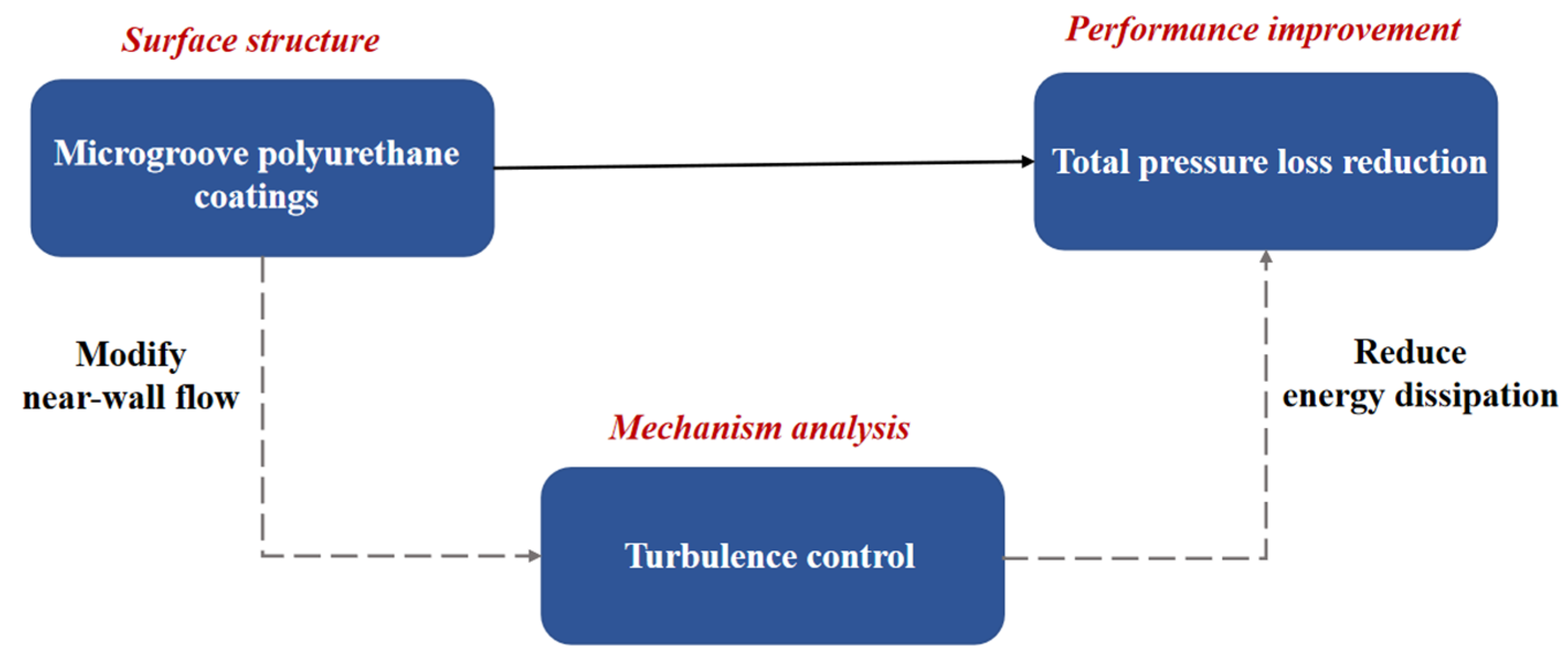
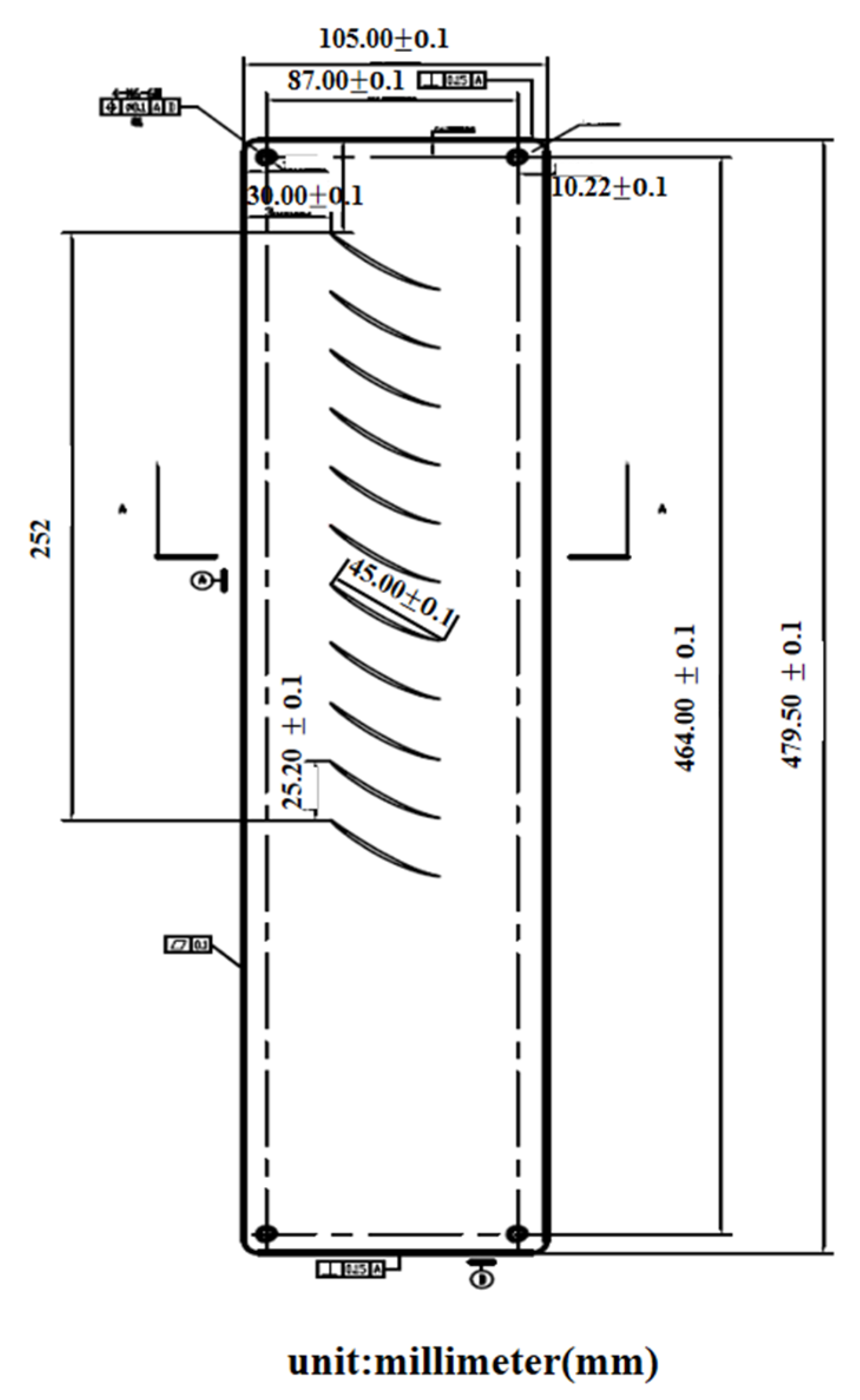
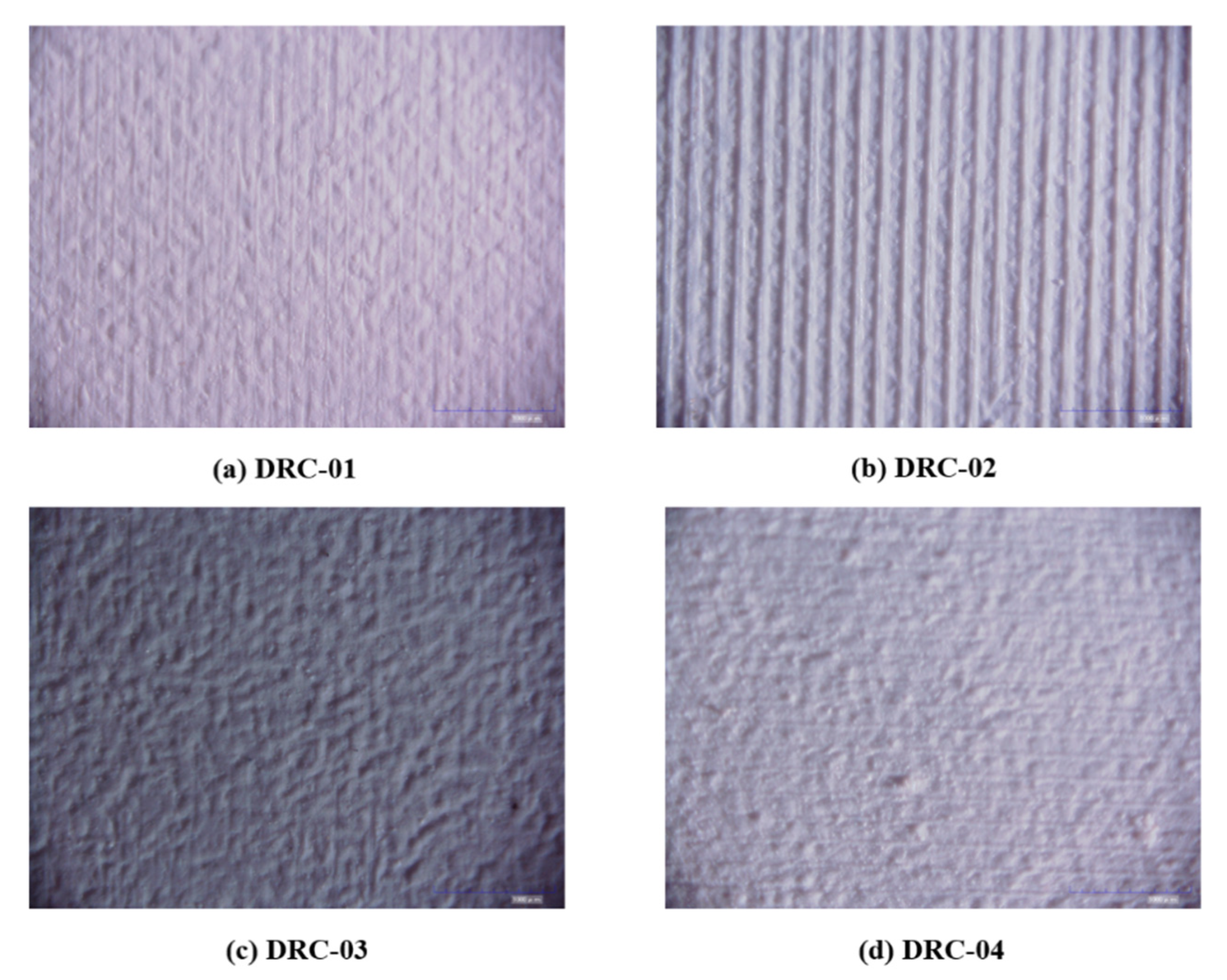
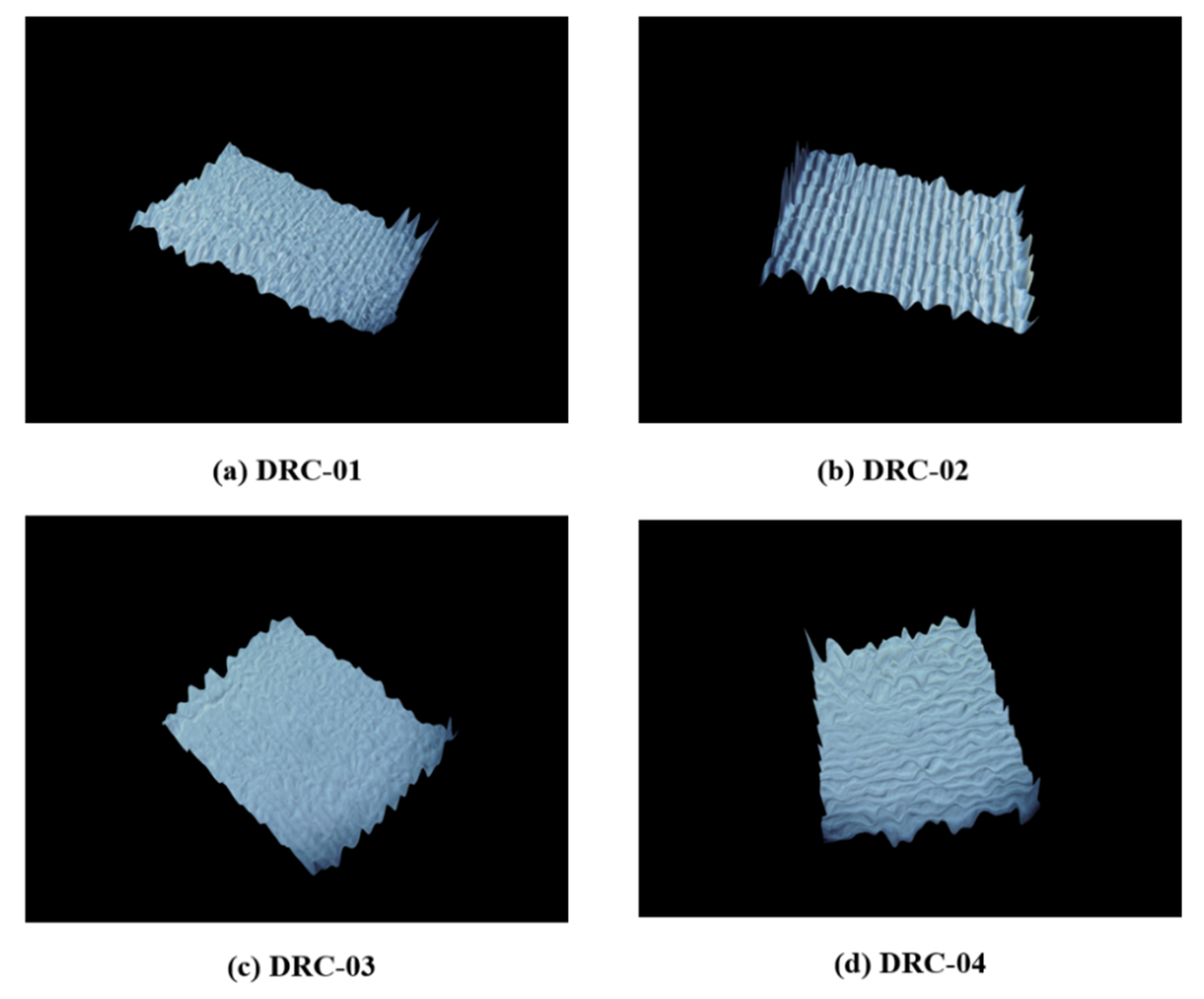
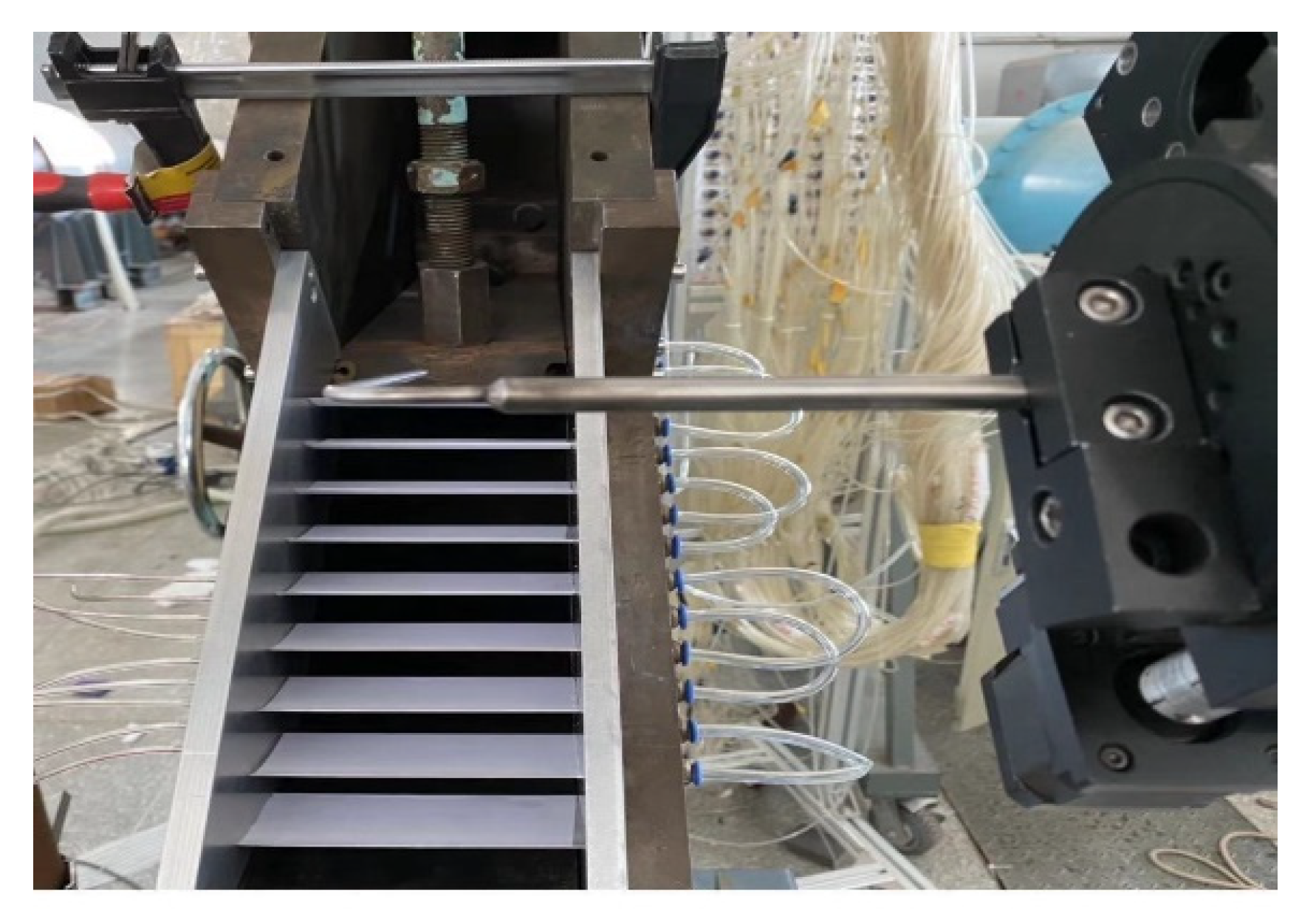

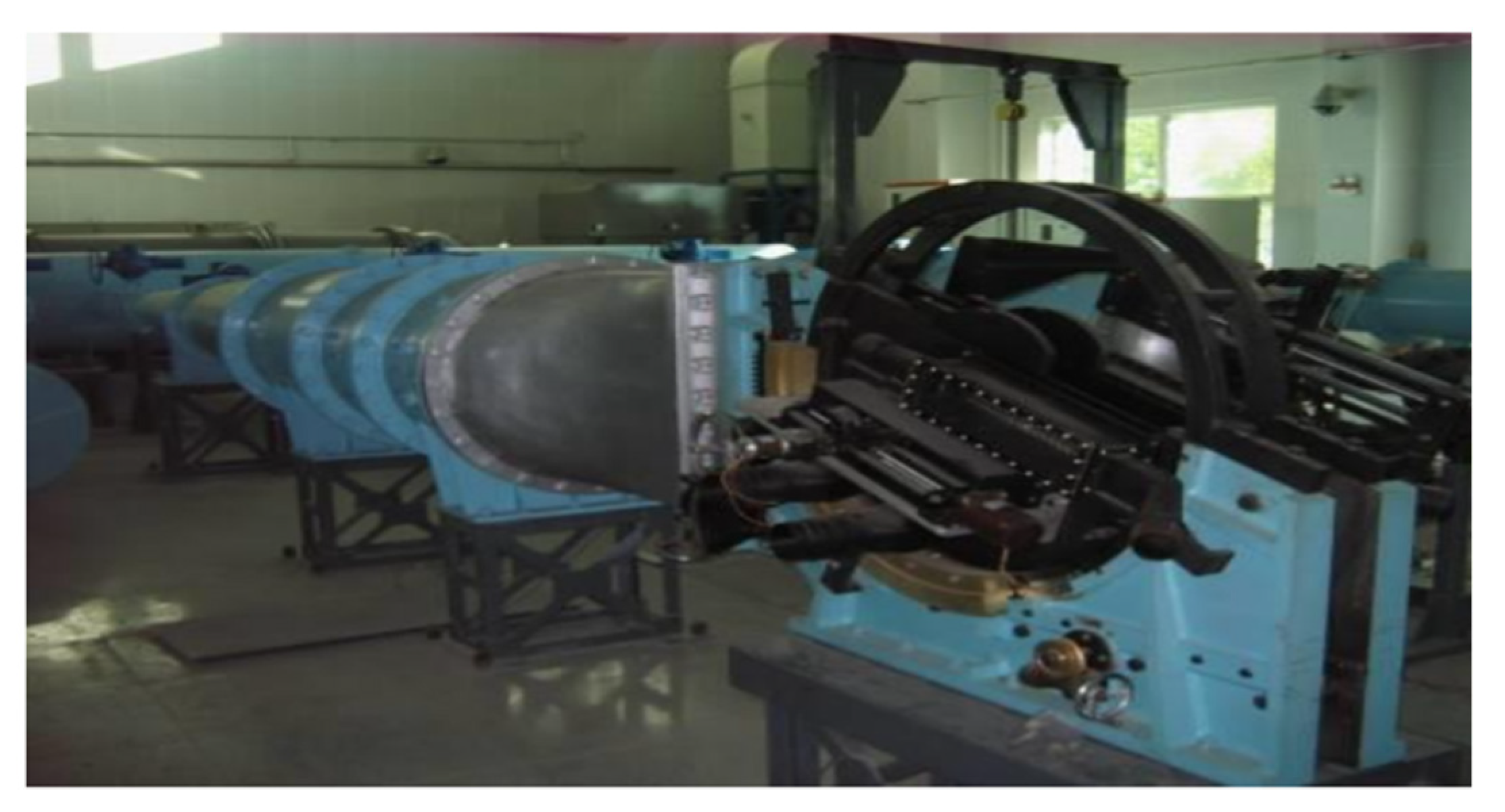
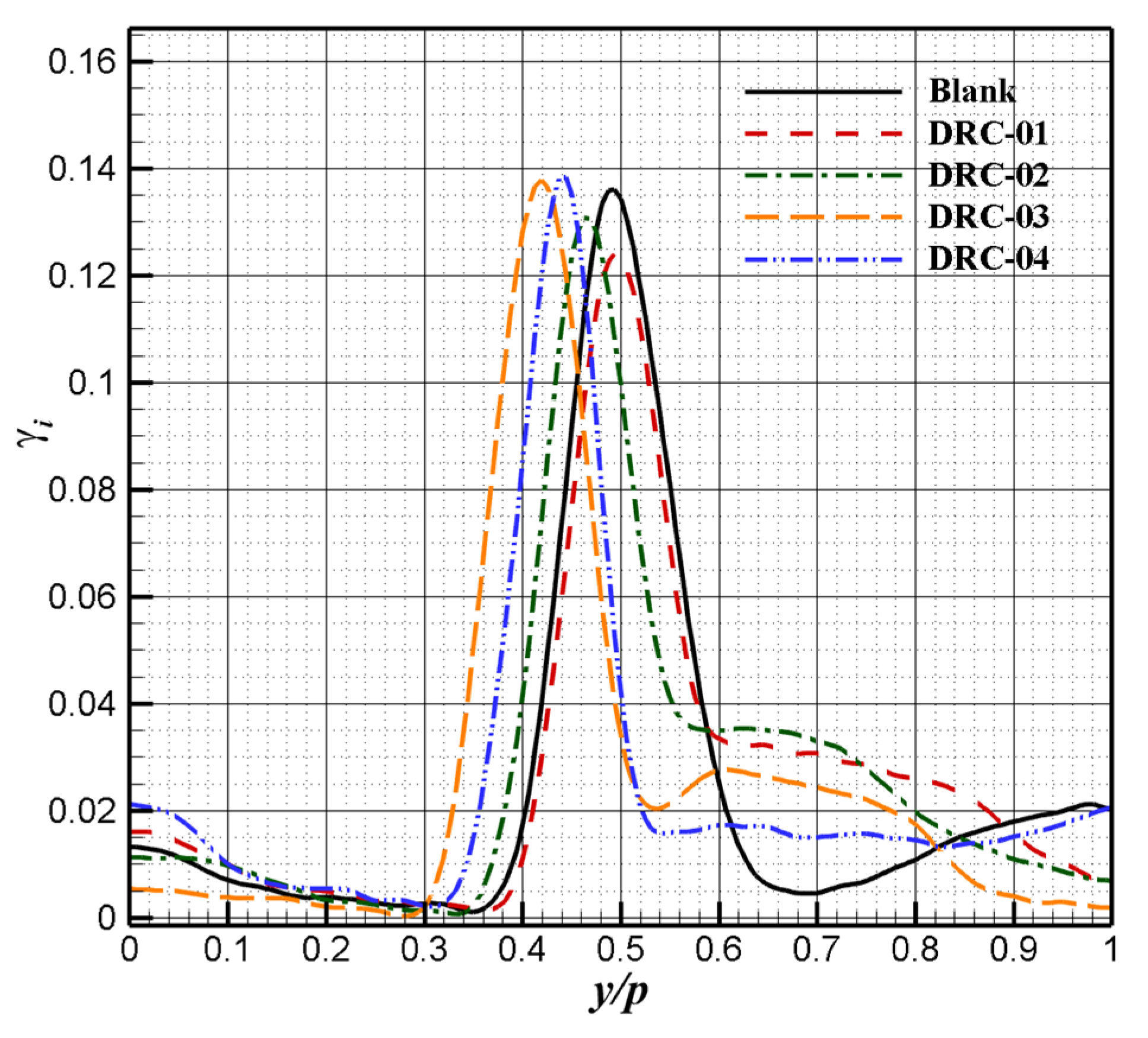
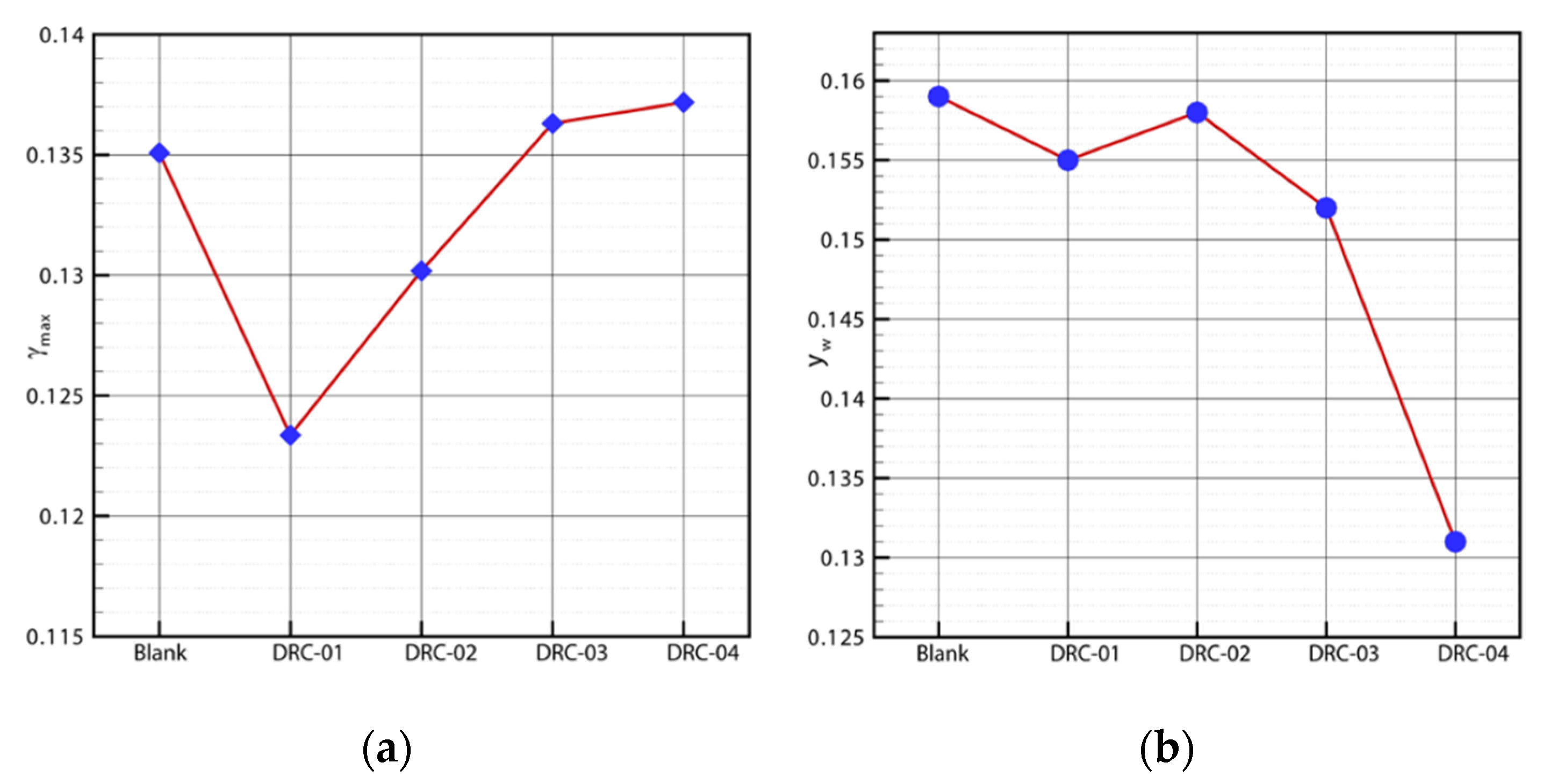

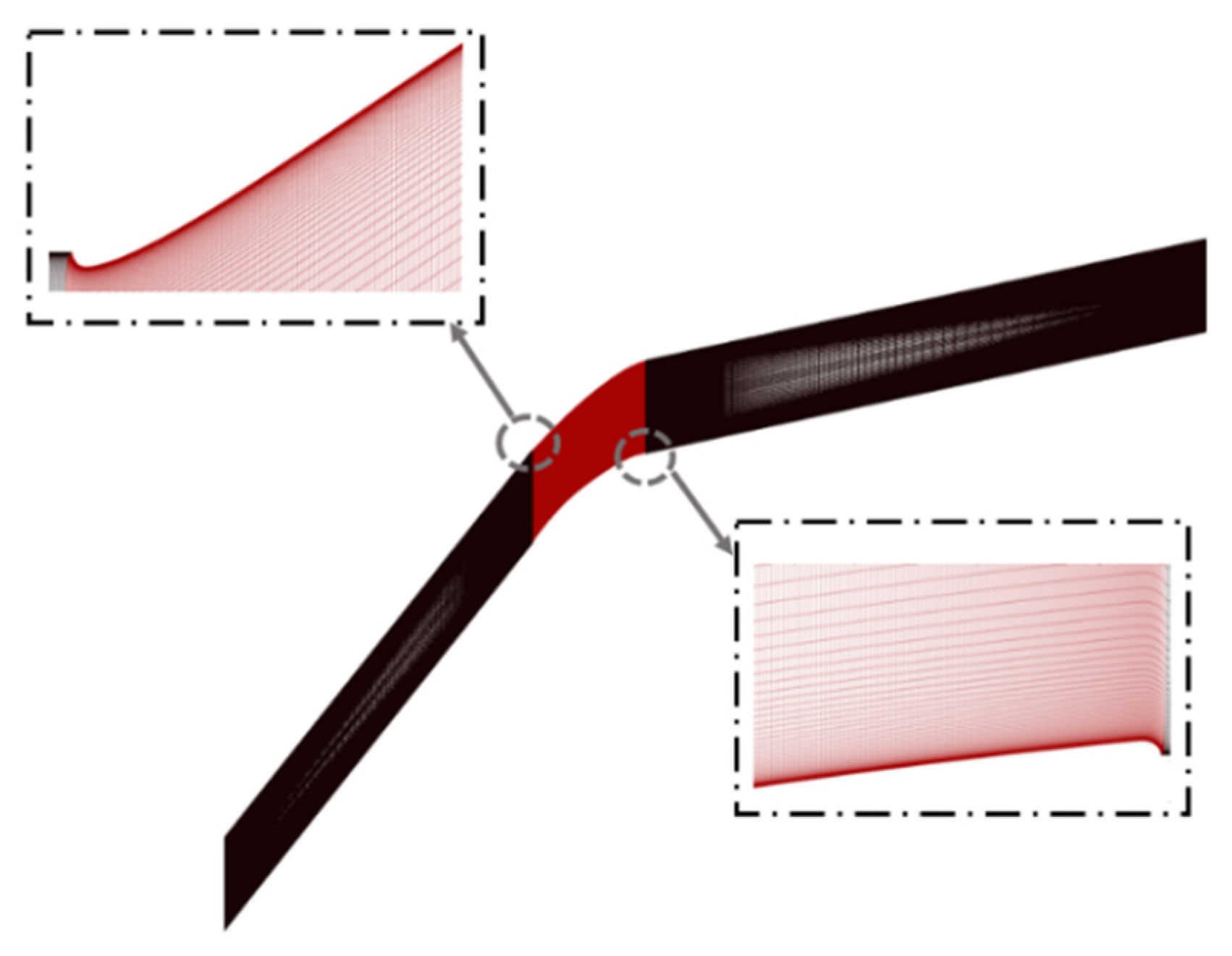
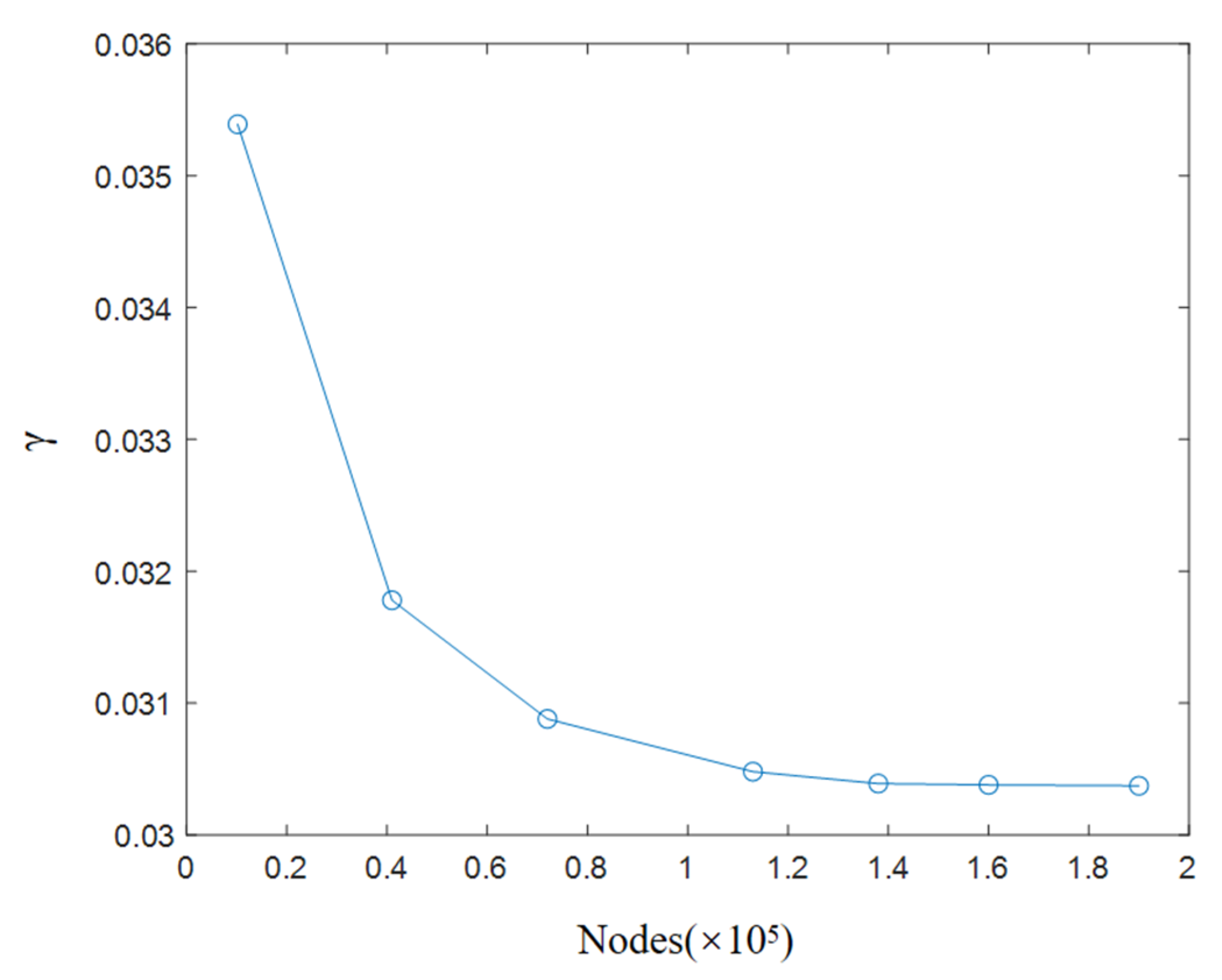
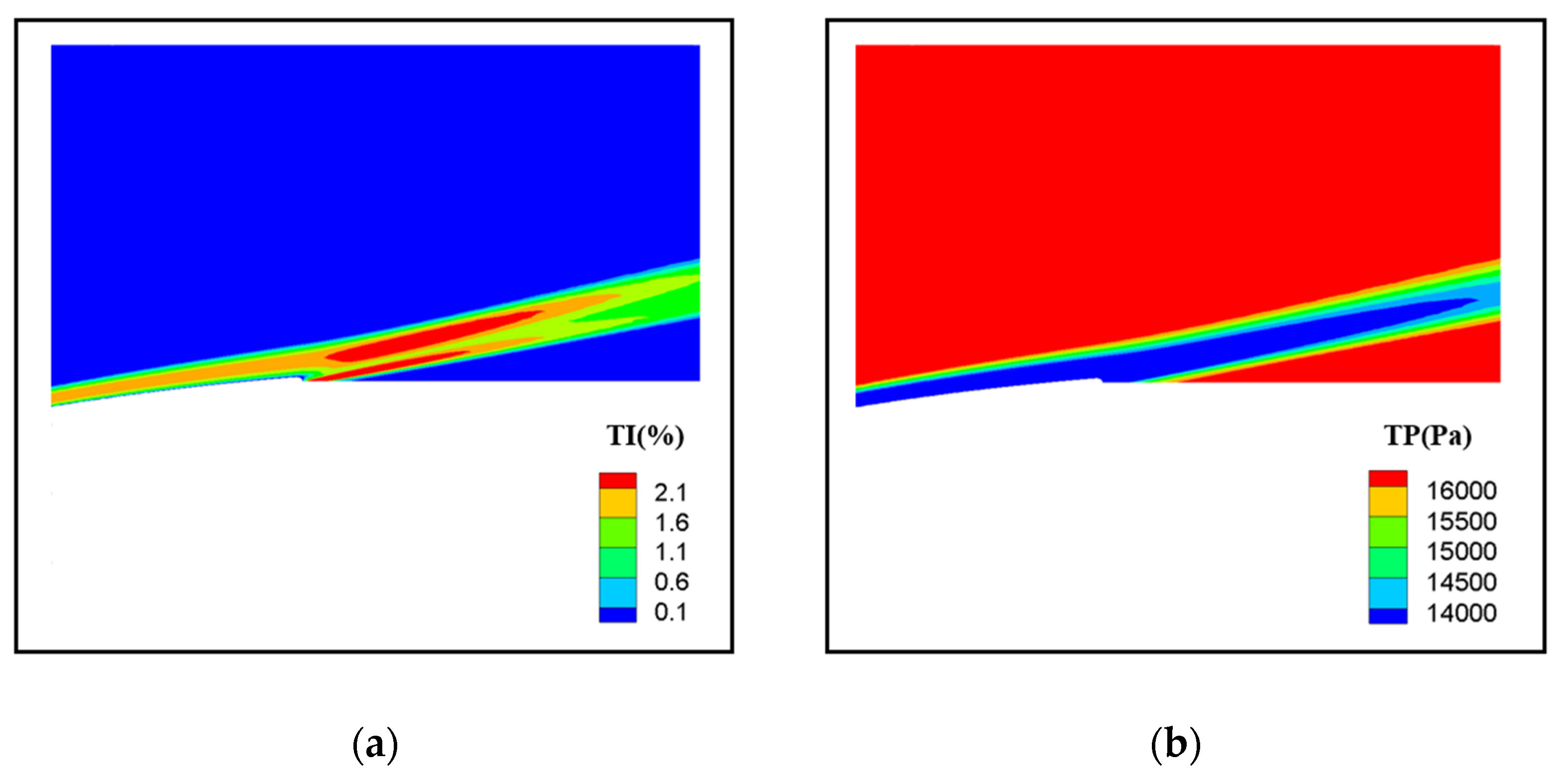
| No. of Samples | Groove Arrangement | Groove Size (μm) |
|---|---|---|
| DRC-01 | Single-direction with nanospheres | 50 |
| DRC-02 | Single-direction with nanospheres | 80 |
| DRC-03 | Multi-direction with nanospheres | 50 |
| DRC-04 | Multi-direction with nanospheres | 80 |
| No. of Samples | Area-Averaged Total Pressure Loss Coefficient γ | |
|---|---|---|
| Blank | 0.03072730 | / |
| DRC-01 | 0.02892361 | 5.87% |
| DRC-02 | 0.03040992 | 1.03% |
| DRC-03 | 0.03082561 | −0.32% |
| DRC-04 | 0.02902376 | 5.54% |
Publisher’s Note: MDPI stays neutral with regard to jurisdictional claims in published maps and institutional affiliations. |
© 2022 by the authors. Licensee MDPI, Basel, Switzerland. This article is an open access article distributed under the terms and conditions of the Creative Commons Attribution (CC BY) license (https://creativecommons.org/licenses/by/4.0/).
Share and Cite
Wang, L.; Wang, C.; Qin, S.; Lan, X.; Sun, G.; You, B.; Wang, M.; Zhong, Y.; Hu, Y.; Lu, H. Experimental Study on Performance of Transonic Compressor Cascade with Microgroove Polyurethane Coatings. Fluids 2022, 7, 190. https://doi.org/10.3390/fluids7060190
Wang L, Wang C, Qin S, Lan X, Sun G, You B, Wang M, Zhong Y, Hu Y, Lu H. Experimental Study on Performance of Transonic Compressor Cascade with Microgroove Polyurethane Coatings. Fluids. 2022; 7(6):190. https://doi.org/10.3390/fluids7060190
Chicago/Turabian StyleWang, Liyue, Cong Wang, Sheng Qin, Xinyue Lan, Gang Sun, Bo You, Meng Wang, Yongjian Zhong, Yan Hu, and Huawei Lu. 2022. "Experimental Study on Performance of Transonic Compressor Cascade with Microgroove Polyurethane Coatings" Fluids 7, no. 6: 190. https://doi.org/10.3390/fluids7060190
APA StyleWang, L., Wang, C., Qin, S., Lan, X., Sun, G., You, B., Wang, M., Zhong, Y., Hu, Y., & Lu, H. (2022). Experimental Study on Performance of Transonic Compressor Cascade with Microgroove Polyurethane Coatings. Fluids, 7(6), 190. https://doi.org/10.3390/fluids7060190






